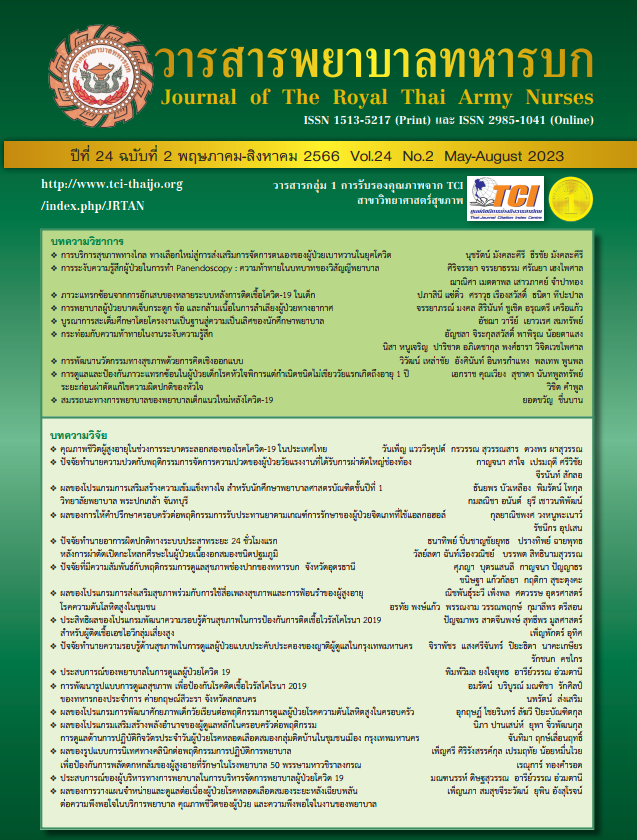Incidence and Factors Associated with Incontinence Associated Dermatitis in Patient Ward Somdech Phra Debaratana Building Faculty of Medicine Ramathibodi Hospital : A Retrospective Matched-Paired Case Control Study Design
Keywords:
Incontinence Associated-Dermatitis, Incidence, factors associatedAbstract
Incontinence Associated-Dermatitis (IAD) can cause discomfort, increase the treatment duration and costs. The objectives of this study were to determine the incidences and factors associated with IAD in a sample group of 64 patients based on historical data from January 1, 2021 to December 31, 2021. Content validity index (CVI) of data collection form developed by the researcher was .91, were reviewed retrospective paired study. The study adopted descriptive statistics, including percentage, mean and standard deviation. Statistics were analyzed using Chi-square test and binary logistic regression analysis to described the factors associated with IAD. The sample group was divided into several experimental groups, namely IAD case group (32 patients) and controlled group (32 patients). The patients’ genders and ages (±5 years) in each group were randomly matched and Barden score with 1:1 match.
The study results indicated that IAD incidences in 2021 was 10.15% and the factors associated with IAD incidence, with statistically significance level of .05, consisted of excretory factors, such as watery bowel movements, health status factors, include fever, antibiotics, diuretics, sleeping pills/sedatives, nutritional deficiencies, length of hospital stay more than 15 days, O2 Saturation < 95% and oxygen requirement. The research results can be applied to create nursing practice guideline for IAD prevention and management.
Downloads
References
Doughty D, Junkin J, Kurz P, Selekof J, Gray M, Fader M, et al. Incontinence-associated dermatitis. Consensus statements, evidence-based guidelines for prevention and treatment, current challenges. Journal Wound Ostomy Continence Nursing 2012;39:303-15.
Barry M, Nugent L. Pressure ulcer prevention in frail older people. Nursing Standard journal 2015;30:50-8.
Park KH, Choi H. Prospective study on incontinence-associated dermatitis and its severity instrument for verifying its ability to predict the development of pressure ulcers in patients with fecal incontinence. International wound journal 2016;13:20-5.
Chartputhananun B. Effectiveness of Implementingthe Clinical Practice Guidelines for Traumatic Wound Pain Management at Emergency Department in Middle-level Hospital. Journal of The Royal Thai Army Nurses 2017;18:101-9. (in Thai)
Gray M, Beeckman D, Bliss DZ, Fader M, Logan S, Junkin J, et al. Incontinence-associated dermatitis:a comprehensive review and update.Journal Wound Ostomy Continence Nursing 2012;39: 61-74.
Campbell JL, Coyer FM, Osborne SR. Incontinence-associated dermatitis:a cross-sectional prevalence study in the Australian acute care hospital setting. International wound journal 2016;13:403-11.
Long M, Reed L, Dunning K, Ying J. Incontienceassociated dermatitis in a long-term acute care facility. Wound Ostomy Continence Nursing 2012;39:318-27.
Uppanisakorn S, Somma T, Vattanaprasan P, Boonyarat J. Prevention and Treatment of Incontinence-Associated Dermatitis (IAD) in Critical Patients Treated in the Intensive Care Unit of a Medical Ward. Thai Journal of Nursing Council 2015;30:86-100. (in Thai).
Ramathibodi Hospital.Incontinence-associated dermatitis annual report. Faculty of Medicine Ramathibodi Hospital; 2021. (in Thai)
Beeckman D et al. Proceedings of the Global IAD Expert Panel. Incontinence associated dermatitis: moving prevention forward. Wounds International 2015.
Johansen E et al. Prevalence and Associated Factors in 4 Hospitals in Southeast Norway. Wound Ostomy Continence Nursing 2018;45:527-31.
Ferreira M, Abbade L, Bocchi SCM, Miot HA, Villas Boas P, Guimaraes HQCP. Incontinenceassociated dermatitis in elderly patients: prevalence and risk factors. Revista Brasileira de Enfermagem 2020;73:1-7.
Rodríguez-Palma M, Verdu-Soriano J, SoldevillaAgreda JJ, Pancorbo-Hidalgo PL, GarciaFernández FP. Conceptual framework for incontinence-associated dermatitis based on scoping review and expert consensus process. Journal of Wound, Ostomy and Continence Nursing 2021;48:239-50.
Fukada M. Nursing competency: definition, structure and development. Yonago Acta Medica 2018;61:1-7.
Kottner J, Blume-Peytavi U, Lohrmann C, Halfens R. Associations between individual characteristics and incontinence-associated dermatitis: a secondary data analysis of a multi-centre prevalence study. International Journal of Nursing Studies 2014;51:1373–80.
Van Damme N , Van den Bussche K , De Meyer D, Van Hecke A, Verhaeghe S, Beeckman D. Independent risk factors for the development of skin erosion due to incontinence (incontinence-associated dermatitis category 2) in nursing home residents: Results from a multivariate binary regression analysis. International Wound Journal 2017;14:801-10.
Damme NV, Clays E, Verhaeghe S, Hecke AV, Beeckman D. Independent risk factors for the development of incontinence-associated dermatitis (category 2) in critically ill patients with fecal incontinence: a cross-sectional observational study in 48 ICU units. International Journal of Nursing Studies 2018; 81:30-9.
Chianca TCM, Gonçales PC, Salgado PO, Machado BO, Amorim GL, Alcoforado CLGC. Incontinence-associated dermatitis: a cohort study in critically ill patients. Revista gaucha de enfermagem 2016;37.
Kliangprom J, Putivanit S. Prevention of skin breakdown in the older person. The Southern College Network Journal of Nursing and Public Health 2017;4:249–58.
Ferreira M, Abbade L, Bocchi SCM, Miot HA, Villas Boas P, Guimaraes HQCP. Incontinenceassociated dermatitis in elderly patients: prevalence and risk factors. Revista gaucha de enfermagem 2020;73.
Downloads
Published
How to Cite
Issue
Section
License
Copyright (c) 2023 Journal of The Royal Thai Army Nurses

This work is licensed under a Creative Commons Attribution-NonCommercial-NoDerivatives 4.0 International License.
บทความหรือข้อคิดเห็นใดใดที่ปรากฏในวารสารพยาบาลทหารบกเป็นวรรณกรรมของผู้เขียน ซึ่งบรรณาธิการหรือสมาคมพยาบาลทหารบก ไม่จำเป็นต้องเห็นด้วย
บทความที่ได้รับการตีพิมพ์เป็นลิขสิทธิ์ของวารสารพยาบาลทหารบก
The ideas and opinions expressed in the Journal of The Royal Thai Army Nurses are those of the authors and not necessarily those
of the editor or Royal Thai Army Nurses Association.






